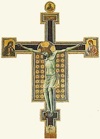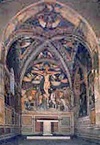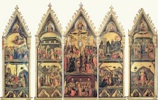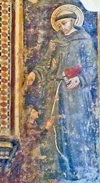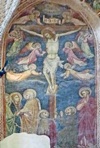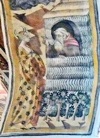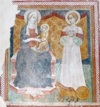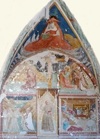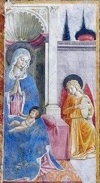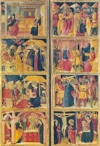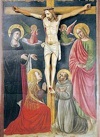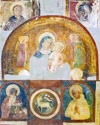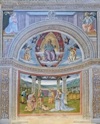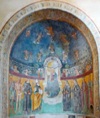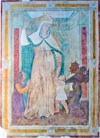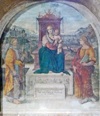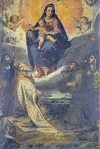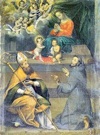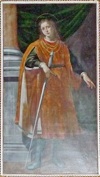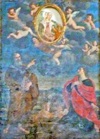

Rainaldo di Ranuccio (13th century)
This painted Crucifix, which was moved from Santa Maria della Selva Mattutina (an abandoned church some 10 km west of Montefalco) to the Pinacoteca in 1938, is attributed to Rainaldo di Ranuccio.
Lorenzo Maitani (died 1330)
From Siena, based in Orvieto from ca. 1308
The papal rector of the Duchy of Spoleto Jean d' Amiel (1322-33) made a payment to Lorenzo Maitani in 1324 for advice on the construction of a fortress next to San Fortunato. Work continued into the early 1330s on what became known as the Palazzo Vecchio.
[Link to Lorenzo Maitani]
Maestro della Dormitio di Terni (ca. 1400)
Probably from Terni
A damaged fresco of the Madonna and Child enthroned, which came from San Giovanni di Colle Mora and is now in the Pinacoteca, is also attributed to the Maestro della Dormitio di Terni.
[Temporary link to the Maestro della Dormitio di Terni]
Maestro Espressionista di Santa Chiara/ Palmerino di Guido (early 14th century)
This Crucifix from San Francesco (now the Pinacoteca) is attributed to this follower of Giotto
Maestri di Santa Chiara di Montefalco (14th century)
The frescoes (1333) in what is now the Cappella di Santa Croce in the nunnery of Santa Chiara da Montefalco are the autograph works of what seem to have been two distinct artists. Jean d’ Amiel, the Rector of the Duchy of Spoleto, commissioned them. There are other frescoes attributed to the first of these masters in Santa Maria di Turrita. Two other works that are attributed to him (from Santa Chiara da Montefalco and San Francesco respectively) were probably removed during the French occupation of 1798, are now in the Vatican.
Maestro di Fossa (14th century)
Active in the Duchy of Spoleto
A polyptych (14th century) that was documented in 1771 in the right aisle of San Francesco, Montefalco (by which time it had already been cut into three parts) is attributed to the Maestro di Fossa. It seems likely that it had originally formed the dossal of the high altar of the church, and that it had been removed in 1562, when the choir screen had been demolished. Its components were documented again at the time of the French invasion of 1798. The panels were subsequently unrecorded until 1973, when Roberto Longhi published details of a dossal in the Pinacoteca Vaticana that he attributed to this master. Silvestro Nessi (referenced below) recognised that the panels matched the 1771 description. They are now in the Vatican Palace.
[Temporary link to the Maestro di Fossa]
Maestro dell' Abside Destra di S Francesco (early 15th century)
The votive frescoes (ca. 1420) in the right apsidal chapel of San Francesco (now the Pinacoteca) are the autograph works of the Maestro dell' Abside Destra di San Francesco di Montefalco. They depict figures of saints (including this figure of St Francis with a donor clutching his cord, a symbol of poverty, as the way to salvation) and scenes from the Passion of Christ.
Giovanni di Corraduccio Mazzaforte (died after 1437)
From Foligno
-
✴Sant’ Agostino;
-
✴Santa Maria Di Turrita ;
-
✴Palazzo Comunale; and
-
✴San Rocco.
Andrea di Cagno (died after 1446)
This artist seems to have belonged to the workshop of Giovanni di Corraduccio (see above). The frescoes of the Cappella di Sant’ Antonio Abate in San Francesco are attributed to him.
Bartolomeo da Miranda (died after 1449)
Three frescoes on the right wall of Santa Maria di Turrita are attributed to Bartolomeo da Miranda, including this one of the Madonna and Child with St Lucy.
Jacopo di Vinciolo (died after 1495)
Works in Montefalco attributed to Jacopo Vinciolo incude:
-
✴in San Francesco:
-
•the frescoes (1461) of the Cappella di San Bernardino (illustrated here); and
-
•the frescoes (ca. 1461) of the niche of St Antony of Padua;
-
✴the frescoes (15th century) in the Cappella del Sacramento of Sant’ Agostino;
-
✴a painted Crucifix (ca. 1461) from Sant’ Agostino, which is now in the Pinacoteca; and
-
✴a detached fresco (1474) of theMadonna and Child in San Leonardo, which is all that remains of what was an extensive and documented series of frescoes here by this artist.
Benozzo Gozzoli (1420-97)
Benozzo Gozzoli produced some of his most important works for the Franciscans of Montefalco. These included:
-
✴the signed fresco (1450) illustrated here and other important works in in San Fortunato; and
-
✴the frescoes (1452) in the apse and in the Cappella di San Girolamo in San Francesco.
Cristoforo di Jacopo (died after 1502)
Works in Montefalco that are attributed to Cristoforo di Jacopo include:
-
✴two in the Pinacoteca:
-
•a panel formed from a pair of shutters decorated with eight scenes from the life of Christ (illustrated here), which came from Santa Maria di Turrita; and
-
•a panel of the Coronation of the Virgin from Sant’ Agostino; and
-
✴a ruined fresco of the Madonna and Child on the exterior of Santa Maria Maddalena and two frescoes inside the church.
Pietro di Giovanni Mazzaforte (died after 1502)
The frescoed backdrop (15th century) to this Crucifix, which is clearly by an artist from Foligno, is attributed somewhat tentatively to Pietro di Giovanni Mazzaforte. The work came from San Fortunato and is now in the Pinacoteca.
Ugolino di Gisberto (died after 1502)
Ugolino di Gisberto trained in the workshop of Pietro di Giovanni Mazzaforte (above) in 1458. This fresco (15th century) in Sant’ Agostino, which depicts the Madonna and Child with St Augustine and the Blessed Angelo of Foligno, is attributed to him.
Bartolomeo Caporali (died after 1505)
A panel (ca. 1470) of the Madonna and Child from the Augustinians’ church of Sant’ Illuminata, which is a copy of a venerated icon in Santa Maria del Popolo, is usually attributed to Melozzo da Forli or (less commonly) to Antoniazzo Romano (see below). However, it has recently been attributed alternatively to Bartolomeo Caporali, who was documented in Rome in 1467.
Antoniazzo Romano (died after 1508)
Two works from the Augustinians’ church of Sant’ Illuminata, which were probably originally painted for their church of Santa Maria del Popolo, Rome, are now in the Pinacoteca:
-
✴the altarpiece (ca. 1488) of three standing saints, which is generally attributed to Antoniazzo Romano (illustrated here); and
-
✴a panel (ca. 1470) of the Madonna and Child that is a copy of a venerated icon in Santa Maria del Popolo, which is sometimes attributed to him. However:
-
•it is more usually attributed to his colleague, Melozzo da Forli; and
-
•it has recently been attributed alternatively to Bartolomeo Caporali (see above), who was documented in Rome in 1467.
Pierantonio Mezzastris (died ca. 1506)
Two works in Montefalco are attributed to Pierantinio Mezzastris:
-
✴the so-called Maestà Bennati and other fresco fragments detached from an aedicule outside Montefalco and moved to the Pinacoteca Civica (illustrated here); and
-
✴a fresco fragment from a Madonna and Child in Sant’ Agostino.
Francesco Melanzio (ca. 1465-1520)
This important local artist was a follower of Perugino. Most of the works by or attributed to him are in Montefalco. His earliest known work is from altarpiece in Sant’ Agostino, Montefalco (illustrated here) that is dated 1487. It is now in the Pinacoteca.
Tiberio d’ Assisi (ca. 1465 - 1524)
Three works by or attributed to Tiberio d’ Assisi survive in Montefalco:
-
✴a signed fresco (1510) of the Madonna and Child with SS Andrew and Bonaventure (illustrated here) in San Francesco;
-
✴an altarpiece (1510, attributed) of the Madonna del Soccorso that Griseida di ser Bastiano commissioned for San Francesco; and
-
✴the signed frescoes (1512) that the same lady commissioned for the Cappella delle Rose, San Fortunato.
Pietro Vannucci, il Perugino (1446–1524)
This fictive frescoed altarpiece (1503) in San Francesco is almost certainly the work for which Brother Francesco Augusti, the Guardian of the convent, paid Perugino in 1503. It depicts the Nativity, with God the Father above.
Andrea della Robbia (1435-1525)
From Florence
Bernardino Mezzastris (died after 1539)
Bernardino was the son of the more famous Pierantonio Mezzastris (above). He emerged as an independent painted after his father’s death in 1506. The frescoes (1507) of the Madonna and Child with saints illustrated here, which are in a niche in Sant’ Illuminata, are his earliest known signed works. The frescoes (1529) in a niche in Sant’ Agostino are also attributed to him.
Febo Melanzio (died 1554)
Febo (Diofebo) was the nephew and student of the more famous Francesco Melanzio (above). He was recorded with Francesco in a document notarised in the cloister of Sant’ Illuminata in 1515, and he was probably involved in the work that Francesco executed in the church in that year. His only other documented works are the designs for the choir of San Lorenzo, Spello. This fresco (1537) in Santa Maria di Turrita, Montefalco is attributed to him.
Giovanni Battista Caporali (ca. 1476-1554)
Giovanni Battista Caporali worked mostly in and around his native city. This fresco (1522) of the Madonna della Cintola in Sant’ Agostino, which is dated by inscription, is attributed to him.
Giacomo Barozzi da Vignola (1507-73)
Vignola had a very successful career in Rome, where he often worked for the papacy. He also worked in Umbria, often as an advisor, at the behest of prominent nobles with interests there. In Montefalco, the design of Palazzo Tempestivi (16th century) in Via Tempestivi is attributed to him. This palace was built by Cherubino Tempestivi, who was the secretary to Pope Clement VIII.
Pietro Rancanelli (died after 1602)
Pietro Rananelli is known from only one signed work, this panel (1602) of the Madonna and Child with saints from San Clemente, which is now in the Pinacoteca. A number of works in Perugia are attributed to him.
Simeone Ciburri (died 1624)
This altarpiece (1605) in the Pinacoteca, which is attributed to Simeone Ciburri, was brought to Montefalco in 1927. It originated in San Francesco al Prato, Perugia.
Valentino Martelli (1550-1630)
From Perugia
-
✴Cappella Bontadosi (1589) in San Francesco; and
-
✴the rebuilt church of Santa Chiara da Montefalco (ca. 1615).
Ascensidonio Spacca, il Fantino (1557-1646)
Ascensidonio Spacca worked mainly in his native Bevagna. The decoration of the Bontadosi Chapel of San Francesco is attributed to him. It comprises:
the altarpiece (1584-6) of the Immaculate Virgin with saints (illustrated here); and
the frescoes (1589) of the chapel, which are now badly damaged.
Andrea Polinori (1586-1648)
Most of the surviving works of Andrea Polinori are in his native city. This altarpiece (17th century) of St Severus in San Fortunato is attributed to him.
Giacinto Gimignani (1606-81)
This panel (17th century) of SS Bartholomew and John the Evangelist on the high altar of San Bartolomeo, which is signed by Giacinto Gimignani, forms the backdrop to a venerated fresco (15th century) of the Madonna and Child.
Francesco Refini (died after 1692)
From Spoleto
Two panels (ca. 1692) on an altar in Santa Chiara, which are attributed to this artist, seem to have been among his last works. They depict:
-
✴the death of St Onuphrius (in the oval altarpiece); and
-
✴the Trinity (above).
[Temporary link to Francesco Refini]
Antonio Maria Garbi (1718-97)
From Tuoro sul Trasimeno, based in Perugia
An altarpiece (18th century) of the Assumption of the Virgin by Antonio Maria Garbi from San Filippo Neri, Montefalco is now in the Pinacoteca. It is a faithful copy of an altarpiece (1637) by Guido Reni from San Filippo Neri, Perugia, which is now in the Musée des Beaux Arts, Lyon.
[Temporary link to Antonio Maria Garbi]



